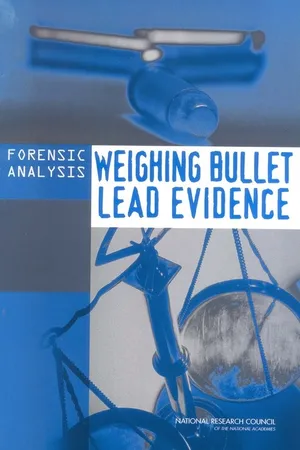
- 227 pages
- English
- PDF
- Available on iOS & Android
About this book
Since the 1960s, testimony by representatives of the Federal Bureau of Investigation in thousands of criminal cases has relied on evidence from Compositional Analysis of Bullet Lead (CABL), a forensic technique that compares the elemental composition of bullets found at a crime scene to the elemental composition of bullets found in a suspects possession. Different from ballistics techniques that compare striations on the barrel of a gun to those on a recovered bullet, CABL is used when no gun is recovered or when bullets are too small or mangled to observe striations. Forensic Analysis: Weighing Bullet Lead Evidence assesses the scientific validity of CABL, finding that the FBI should use a different statistical analysis for the technique and that, given variations in bullet manufacturing processes, expert witnesses should make clear the very limited conclusions that CABL results can support. The report also recommends that the FBI take additional measures to ensure the validity of CABL results, which include improving documentation, publishing details, and improving on training and oversight.
Frequently asked questions
- Essential is ideal for learners and professionals who enjoy exploring a wide range of subjects. Access the Essential Library with 800,000+ trusted titles and best-sellers across business, personal growth, and the humanities. Includes unlimited reading time and Standard Read Aloud voice.
- Complete: Perfect for advanced learners and researchers needing full, unrestricted access. Unlock 1.4M+ books across hundreds of subjects, including academic and specialized titles. The Complete Plan also includes advanced features like Premium Read Aloud and Research Assistant.
Please note we cannot support devices running on iOS 13 and Android 7 or earlier. Learn more about using the app.
Information
Table of contents
- FrontMatter
- Acknowledgment of Reviewers
- Preface
- Contents
- Executive Summary
- 1 Introduction
- 2 Compositional Analysis
- 3 Statistical Analysis of Bullet Lead Data
- 4 Interpretation
- 5 Major Findings and Recommendations
- APPENDIXES
- A Statement of Task
- B Committee Membership
- C Committee Meeting Agendas
- D Glossary
- E Basic Principles of Statistics
- F Simulating False Match Probabilities Based on Normal Theory
- G Data Analysis of Table 1, Randich et al.
- H Principal Components Analysis: How Many Elements Should Be Measured?
- I Birthday Problem Analogy
- J Understanding the Significance of the Results of Compositional Analysis of Bullet Lead
- K Statistical Analysis of Bullet Lead Data